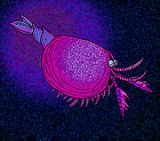
Occacaris
Encyclopedia
Occacaris oviformis was a nekton
ic predatory arthropod
from the Lower Cambrian
Maotianshan shale Lagerstätte
. It bears a superficial resemblance to the Cambrian arthropod, Canadaspis
, though, was much smaller, and had a pair of "great appendages," with which it may have grasped prey with.
It had a bivalved carapace that covered most of its body, leaving only the last two tergites of its trunk, with the telson
jutting out of the posterior end of the carapace, and the eyes, antenna
e, and great appendage
s jutting out of the anterior end. The spines of the great appendages are paired, setting it apart from its relatives, Fortiforceps foliosa, and Forfexicaris valida
.
Nekton
Nekton refers to the aggregate of actively swimming aquatic organisms in a body of water able to move independently of water currents....
ic predatory arthropod
Arthropod
An arthropod is an invertebrate animal having an exoskeleton , a segmented body, and jointed appendages. Arthropods are members of the phylum Arthropoda , and include the insects, arachnids, crustaceans, and others...
from the Lower Cambrian
Cambrian
The Cambrian is the first geological period of the Paleozoic Era, lasting from Mya ; it is succeeded by the Ordovician. Its subdivisions, and indeed its base, are somewhat in flux. The period was established by Adam Sedgwick, who named it after Cambria, the Latin name for Wales, where Britain's...
Maotianshan shale Lagerstätte
Lagerstätte
A Lagerstätte is a sedimentary deposit that exhibits extraordinary fossil richness or completeness.Palaeontologists distinguish two kinds....
. It bears a superficial resemblance to the Cambrian arthropod, Canadaspis
Canadaspis
Canadaspis was a Cambrian genus of crustacean or euarthropod, a benthic feeder that moved mainly by walking and possibly used its biramous appendages to stir mud in search of food...
, though, was much smaller, and had a pair of "great appendages," with which it may have grasped prey with.
It had a bivalved carapace that covered most of its body, leaving only the last two tergites of its trunk, with the telson
Telson
The telson is the last division of the body of a crustacean. It is not considered a true segment because it does not arise in the embryo from teloblast areas as do real segments. It never carries any appendages, but a forked "tail" called the caudal furca is often present. Together with the...
jutting out of the posterior end of the carapace, and the eyes, antenna
Antenna (biology)
Antennae in biology have historically been paired appendages used for sensing in arthropods. More recently, the term has also been applied to cilium structures present in most cell types of eukaryotes....
e, and great appendage
Great appendage
Great appendages are large claw-like appendages which attach to the heads of the "great appendage arthropods", a group whose monophyly is debated, but which includes the anomalocaridids...
s jutting out of the anterior end. The spines of the great appendages are paired, setting it apart from its relatives, Fortiforceps foliosa, and Forfexicaris valida
Forfexicaris valida
Forfexicaris valida is a species of Lower Cambrian arthropod, the only species in the family Forfexicarididae. It is known from only two specimens from the Maotianshan shale .-Description:...
.
See also
- ArthropodArthropodAn arthropod is an invertebrate animal having an exoskeleton , a segmented body, and jointed appendages. Arthropods are members of the phylum Arthropoda , and include the insects, arachnids, crustaceans, and others...
- Cambrian explosionCambrian explosionThe Cambrian explosion or Cambrian radiation was the relatively rapid appearance, around , of most major phyla, as demonstrated in the fossil record, accompanied by major diversification of other organisms, including animals, phytoplankton, and calcimicrobes...
- Chengjiang biota

